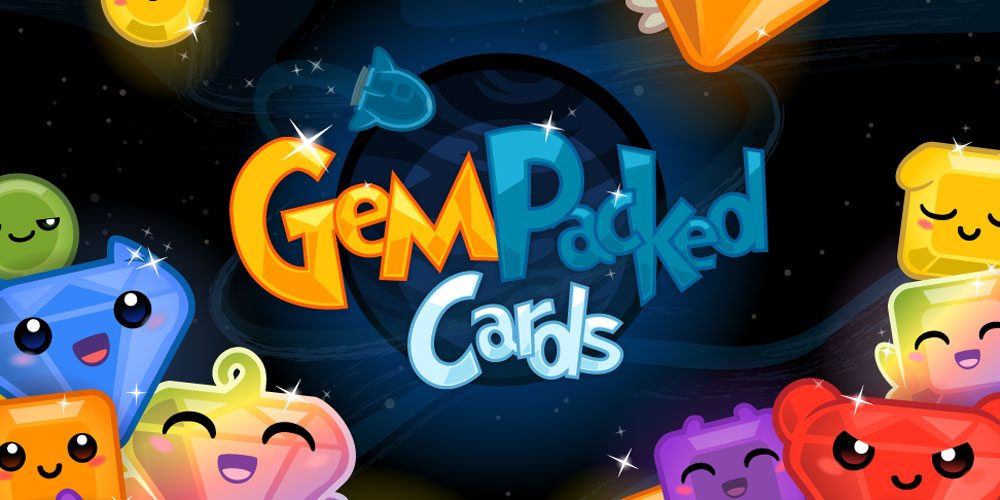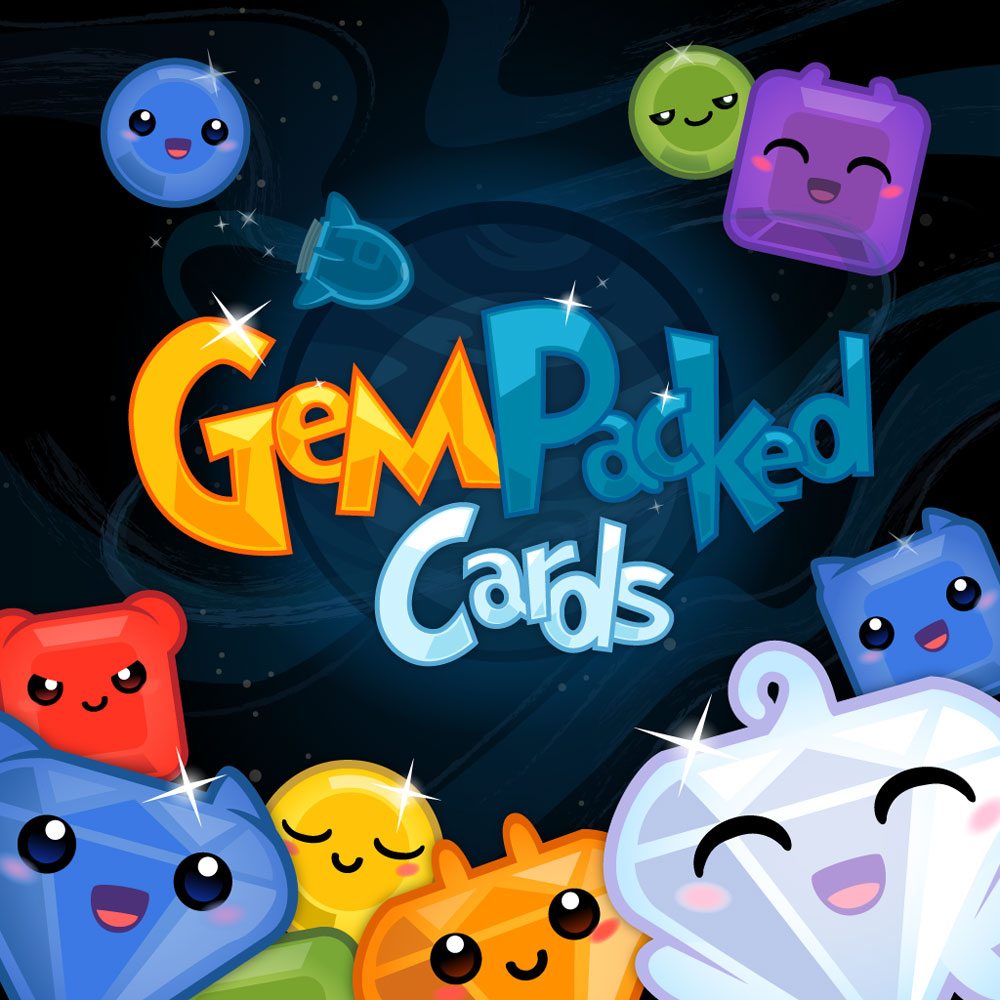Digital and tabletop games are blending into each other more and more often, and this Kickstarter project from Eduardo Baraf is a good example of that. GemPacked is a single-player puzzle game for iOS, and GemPacked Cards is a tabletop game based on the app, though with somewhat different gameplay.
At a glance: GemPacked Cards is for 2 to 5 players, ages 8 and up, and takes about 20 minutes to play. It’s currently seeking funding on Kickstarter, with a pledge level of $25 (plus shipping) for a copy of the game. The game is definitely family-friendly, with adorable graphics and easy-to-learn gameplay. The iOS app is not a part of the Kickstarter campaign and should be available directly from the iTunes store today; I’ll talk a little bit about the app after discussing the card game.
New to Kickstarter? Check out our crowdfunding primer.
Components:
- 118 cards (2 decks of 49 cards each, plus 12 goal cards)
- 100 Gemino Pip tokens (50 with yellow backs, 50 with blue backs)
- 1 Gemino Pip bag
Note: my review is based on a prototype of the game. Final components may be subject to change.
The cards depict either squares or diamonds, which come in each of the primary and secondary colors, as well as some special rainbow versions. Each one has a number in the bottom corner indicating its point value, and a small letter in the other corner indicating its color, for color-blind players. (The rainbow cards are labeled “W” for “wild.”)
The Gemino Pips are cute little circles with faces on them. The pips in my set weren’t labeled for color-blindness, but I’ve been told these will be updated with the letter call-outs in the final version.
How to Play
You can download a copy of the rules here.
The goal of the game is to score the most points by buying cards using combinations of Gemino pips, squares, and diamonds.
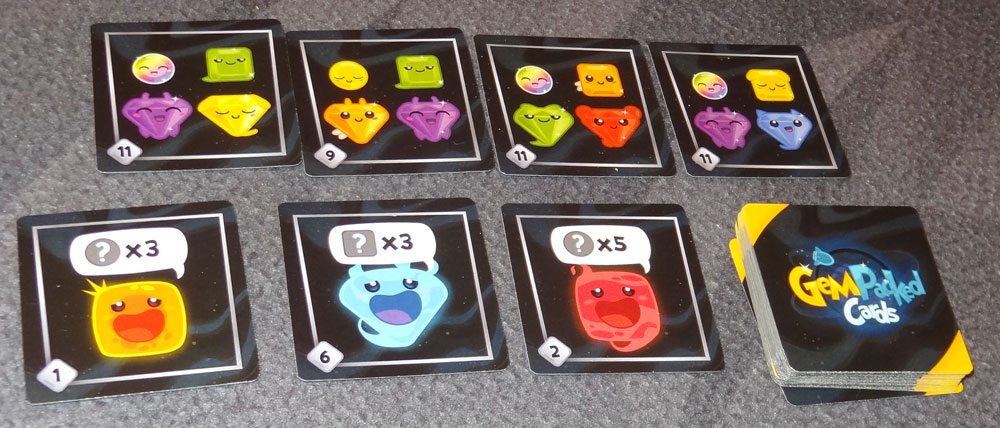
The set up varies based on number of players: for more players you’ll use more cards and pips. To set up, you’ll shuffle and set out a few goal cards plus some combination of Sun, Red Dwarf, and Nova cards. Then you’ll shuffle up the GemPacked cards and lay some face-up in a grid. Finally, the pips will be placed in the bag and mixed up. Each player draws 2 pips at random from the bag.

The basic formula in the game is that 2 pips = 1 square, and 2 squares = 1 diamond. Primary colors can be combined to make a secondary color, so you could buy an orange square either with 2 orange pips or 1 yellow pip and 1 red pip. Likewise, if you convert an orange square into pips, you can convert it into 2 orange pips or 1 yellow pip and 1 red pip. When pips are spent, they go into a common pool on the table and are then available when converting squares to pips.
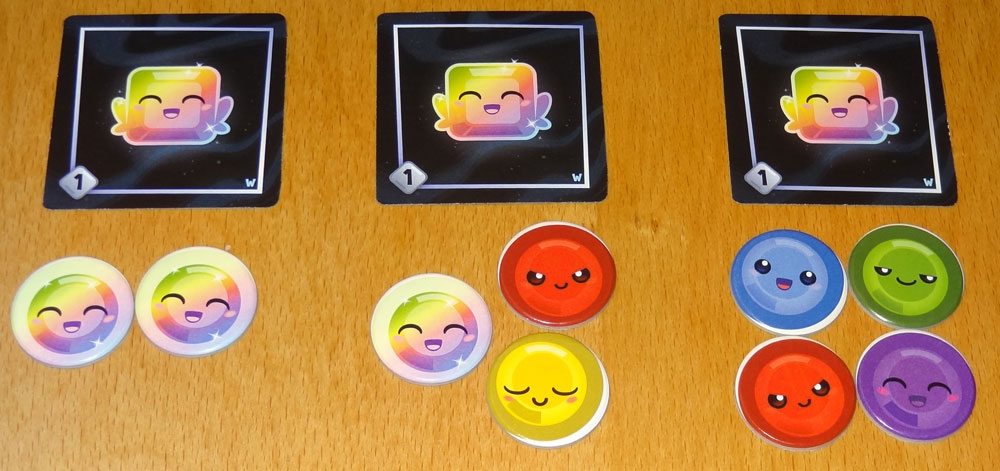
There are also some special rainbow pips, squares, and diamonds. Rainbow pips can be used as a wild. However, for the rainbow squares you may use 2 rainbow pips, or 1 rainbow pip and 2 other unique colors, or 4 unique colors. The rainbow diamonds use the same ratio of squares.
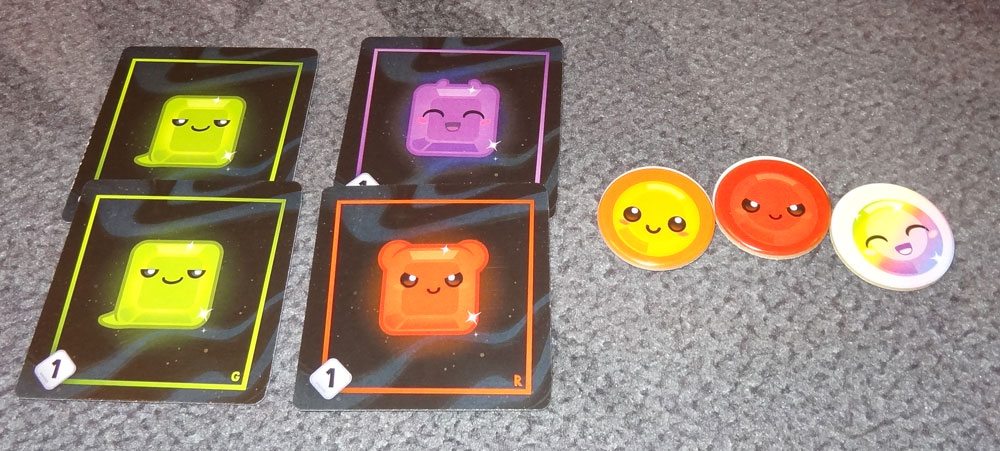
On your turn, you draw 2 pips from the bag, and then you can take any number of actions: buy squares and diamonds, sell squares for pips, or buy goal cards. The goal cards each show four things–some combination of pips, squares, and diamonds, which you turn in to purchase the goal card. The Sun, Red Dwarf, and Nova cards can be purchased with 3 pips, 5 pips, or 3 squares, respectively, in any combination of colors.
If you cannot purchase anything from the grid, then you draw 1 additional pip from the bag.
Finally, at the end of your turn, any empty spaces in the grid are refilled from the deck. If the deck is empty, reshuffle the discard pile.

There are a couple of special cards: the Chomet and Asteroids. Chomet cards remove an adjacent card from the grid and then are discarded. Asteroids allow all players to draw 1, 2, or 3 pips from the bag.
When the last pip is drawn from the bag, each player gets one more turn, and then the game ends. You score for all the cards you have, and the player with the most points wins. In case of a tie, the player with most pips left wins.
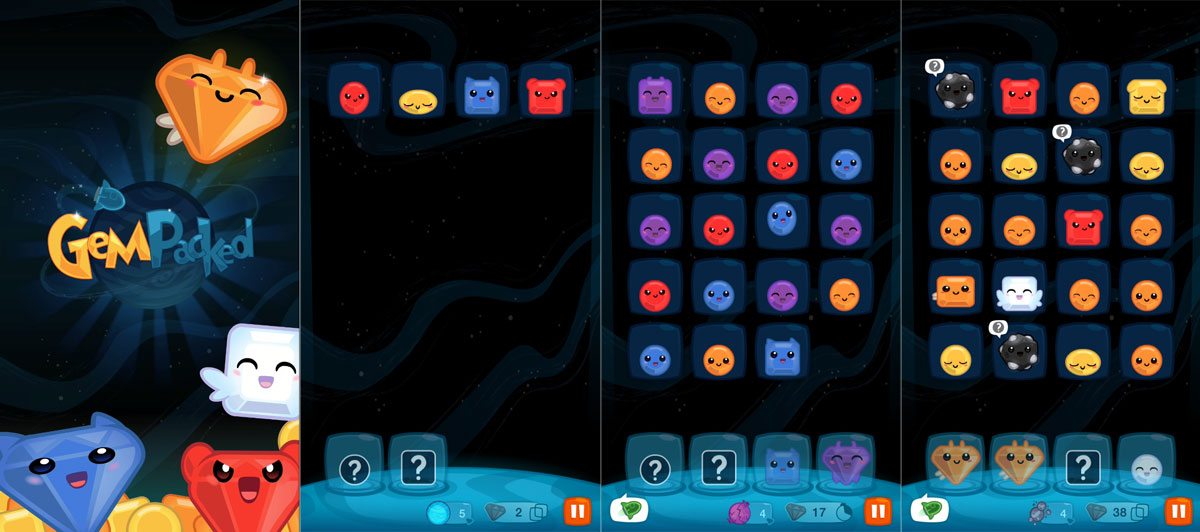
The App
Last month when I was trying out the GemPacked Cards game, I was also testing out the app, which was in beta at the time. In this case, the app actually came first and then the card game was developed based on the app.
In the GemPacked app, there are a series of levels, grouped into worlds, and in each level you must acquire certain elements. Sometimes pips, sometimes squares, sometimes diamonds. The beginning of the game is easy: you need three pips, and the grid shows three pips, so you just drag them to their containers. As it progresses, you’ll learn how to combine pips into squares, and combine squares into diamonds. One big difference is that the app uses a 4:1 ratio for combining things, instead of the 2:1 of the card game.
Then you’ll need to break things apart–but in the app, when you break apart a secondary color, you just get four of that color–you don’t get the primary colors that make it up. Instead of rainbow, there are white elements that combine in a slightly different manner than the rainbow elements of the card game.
You’ll encounter the Sun and Nova, which have to be fed pips or diamonds to be satisfied before they can be acquired. There are Asteroids which will reward you with various elements. The “goal cards” from the game show up in the form of locks–you’ll have to collect four elements, put them into the lock, and then drag that down into the goal area to unlock a container and find out what you’re supposed to get.
The puzzles do get increasingly difficult, particularly because you’re limited to a 4×3 grid. If there isn’t enough room to explode a square into 4 pips, then you can’t do it until you’ve made more room. If you do solve a level, you can also try to earn a gold diamond by completing it in a set number of moves or within a certain time limit–the time limits were particularly challenging for me.
Although the app and the card game share the same graphics and general concept, they do play quite differently–the app is a single-player puzzle, whereas the card game is a multiplayer card game. However, I can see how playing the app could help you learn strategies for the card game–though you’ll have to remember the rules differences between the two!
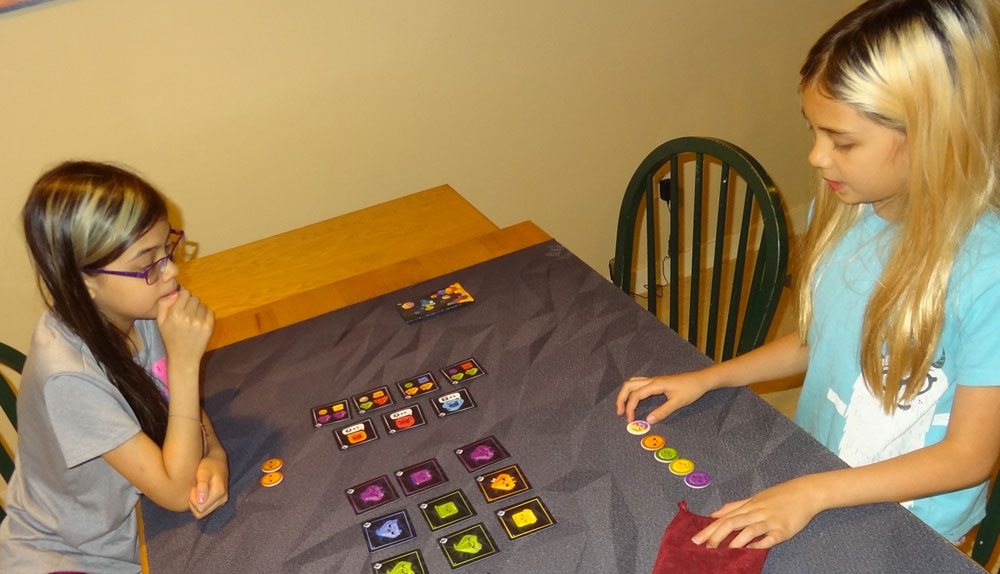
The Verdict
I’ve played GemPacked Cards with my kids a few times, and it’s been fun. The kids really love the adorable faces (and have even ranked them according to cuteness). My 8-year-old does need some reminding about combining primary colors to make secondary colors, but other than that they were able to grasp the rules pretty easily.
The game looks fun and playful, but it can also be somewhat cutthroat, as my kids discovered when they were both going after the same goal card. While you can’t always interfere directly with another player, sometimes you can purchase things that you know they want, or even purchase a square, sell it for pips, and then purchase another of the same square–just to prevent another player from getting them.
There were some aspects of GemPacked Cards that reminded me a little of Splendor: you’ve got gems, which you spend on cards, which can in turn help you purchase other cards. And the goal cards reminded me a little of the Nobles in Splendor–you need to get a certain set of things to get the goal card. There are a lot of differences, of course, the biggest being that you don’t get any sort of discounts for having cards–you always have to spend whatever you’re using to buy the next thing. So there isn’t the engine-building aspect of Splendor.
Another key difference is that the pips you end up with are luck of the draw rather than choice. While that does mean a little less choice, in this case I don’t think it’s a bad idea. Since you can do any number of actions on your turn, once you’ve gotten into the game and have amassed some more pips and cards, there are really a whole lot of actions you can take, buying and selling cards to get the right combinations. Throwing the choice of pips into this mix could lead to extremely long turns, and would also be a little too powerful, I think.
The downside to the “any number of actions” is that the turns can take a while once you hit mid-game, and other players can get impatient for their turn while somebody’s hemming and hawing about which things to buy or sell. Fortunately, the whole game doesn’t last that long anyway, because eventually you’ll run out of pips in the bag.
My kids really enjoyed GemPacked Cards and I thought it was a clever little set-collection game. I haven’t played enough yet to know if there’s an optimal strategy, but we’ve had a mix of winning strategies so far. Sometimes buying the most valuable goal card can give you a leg up, but other times going after a lot of diamonds (the primary colors are worth more points than the secondary colors) can net you just as many points.
For more about GemPacked Cards, check out the Kickstarter page.
